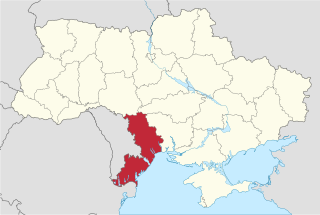
Odesa is the third most populous city and municipality in Ukraine and a major seaport and transport hub located in the south-west of the country, on the northwestern shore of the Black Sea. The city is also the administrative centre of the Odesa Raion and Odesa Oblast, as well as a multiethnic cultural centre. As of January 2021, Odesa's population was approximately 1,010,537. On 25 January 2023, its historic city centre was declared a World Heritage Site and added to the List of World Heritage in Danger by the UNESCO World Heritage Committee in recognition of its influence on cinema, literature, and the arts. The declaration was made in response to the bombing of Odesa during the 2022 Russian invasion of Ukraine, which has damaged or destroyed buildings across the city.

The Odessa massacre was the mass murder of the Jewish population of Odessa and surrounding towns in the Transnistria Governorate during the autumn of 1941 and the winter of 1942 while it was under Romanian control. It was one of the worst massacres in Ukrainian territory.

The OdesaNational Academic Opera and Ballet Theatre is the oldest theatre in Odesa, Ukraine. The Theatre and the Potemkin Stairs are the most famous edifices in Odesa.

Zatoka is an urban-type settlement in Bilhorod-Dnistrovskyi Raion, Odesa Oblast, in southwestern Ukraine. It belongs to Karolino-Buhaz rural hromada, one of the hromadas of Ukraine. The population of Zatoka is 1,972 . Its name comes from the Ukrainian-language word zatoka, meaning "bay".

The Transfiguration Cathedral in Odesa is the Orthodox Cathedral in Odesa, Ukraine, dedicated to the Transfiguration of Jesus and belongs to the Ukrainian Orthodox Church. It was severely damaged by a Russian missile attack on Odesa on July 23, 2023.
Stanislav Sychov was a Ukrainian artist, one of the founders of the Odesa school unofficial (underground) art.
The following is a timeline of the history of the city of Odesa, Ukraine.

Odesa Museum of Western and Eastern Art is a museum of Fine Arts on Pushkin street in Odesa, Ukraine.

Odesa National Fine Arts Museum or Odesa National Art Museum is one of the principal art galleries of the city of Odesa in Ukraine. Founded in 1899, it occupies the Potocki Palace, itself a monument of early 19th century architecture. The museum now houses more than 10 thousand pieces of art, including paintings by some of the best-known Russian and Ukrainian artists of late 19th and early 20th century. It is the only museum in Odesa that has free entrance day every last Sunday of the month.

From the end of February 2014, demonstrations by Russian-backed, pro-Russian, and anti-government groups took place in major cities across the eastern and southern regions of Ukraine in the aftermath of the Euromaidan and the Revolution of Dignity, which resulted in the ousting of Russian-leaning President Viktor Yanukovych. The unrest, which was supported by Russian military and intelligence, belongs to the early stages of the Russo-Ukrainian War.

The Association "Struggle" was a left-wing stalinist organization operating in Odesa, Kharkiv, Kyiv, and Dnipro in Ukraine.

In early 2014, there were clashes between rival groups of protestors in the Ukrainian city of Odesa, during the pro-Russian unrest that followed the Ukrainian Revolution. The street clashes were between pro-unity protesters and anti-government (anti-Maidan), pro-Russian protesters. Violence erupted on 2 May, when a 'United Ukraine' rally was attacked by pro-Russian separatists. Stones, petrol bombs and gunfire were exchanged; two pro-Ukraine activists and four pro-Russia activists were shot dead in the clashes. The pro-Ukraine protesters then moved to dismantle a pro-Russian protest camp in Kulykove Pole, causing some pro-Russian activists to barricade themselves in the nearby Trade Unions House. Shots were fired by both sides, and the pro-Ukraine protesters attempted to storm the building, which caught fire as the two groups threw petrol bombs at each other.
Domanivka is an urban-type settlement in Voznesensk Raion in the west of Mykolaiv Oblast, Ukraine. It hosts the administration of Domanivka settlement hromada, one of the hromadas of Ukraine. Population: 5,728.

Ivanivka is an urban-type settlement in Berezivka Raion, in the west of Odesa Oblast, Ukraine. It hosts the administration of Ivanivka settlement hromada, one of the hromadas of Ukraine. Population: 2,362.
Vasiliy Ryabchenko is a Ukrainian painter, photographer, and installation artist. One of the key artists in contemporary Ukrainian art, and the "New Ukrainian Wave".

The Museum of Concrete is the first museum in Ukraine dedicated to concrete. The museum is in Odesa on the site of an enterprise that produces building materials. The opening of the museum was held on December 5, 2017. At the time of the opening, two thematic halls were organized. Since January 2018, two rooms have been added. As of May 2018, the museum collection numbered about 2500 exhibits, which are associated with concrete and the technology of its production.

Odesa Oblast, also referred to as Odeshchyna (Одещина), is an oblast (province) of southwestern Ukraine, located along the northern coast of the Black Sea. Its administrative centre is the city of Odesa. Population: 2,351,382.

The history of the Jews in Odesa dates to 16th century. Since the modern city's founding in 1795, Odesa has been home to one of the largest population of Jews in what is today Ukraine. They comprised the largest ethno-religious group in the region throughout most of the 19th century and until the mid-20th century.

During the southern Ukraine offensive of the Russian invasion of Ukraine, the city of Odesa and the surrounding region have been the target of shelling and air strikes by Russian forces on multiple occasions since the conflict began, fired predominantly from Russian warships situated offshore in the Black Sea. The city has also been targeted by Russian cruise missiles.
















